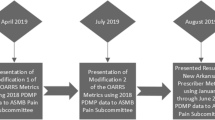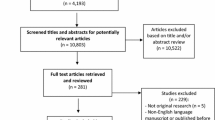Abstract
The misuse, abuse and diversion of controlled substances have reached epidemic proportion in the United States. Contributing to this problem are providers who over-prescribe these substances. Using one state’s prescription drug monitoring program, we describe a series of metrics we developed to identify providers manifesting unusual and uncustomary prescribing practices. We then present the results of a preliminary effort to assess the concurrent validity of these algorithms, using death records from the state’s vital records database pertaining to providers who wrote prescriptions to patients who then died of a medication or drug overdose within 30 days. Metrics manifesting the strongest concurrent validity with providers identified from these records related to those who co-prescribed benzodiazepines (e.g., valium) and high levels of opioid analgesics (e.g., oxycodone), as well as those who wrote temporally overlapping prescriptions. We conclude with a discussion of a variety of uses to which these metrics may be put, as well as problems and opportunities related to their use.


Similar content being viewed by others
Notes
For further information, see the National Alliance for Model State Drug Laws at http://www.namsdl.org/prescription-monitoring-programs.cfm.
391, 402, 403, 404, 406, 424, 426, 428, 430, 432, 435, 436, 455, 450, 461, 462, 465, 476, and 509.
References
Baumblatt, J. A. G., Wiedeman, C., Dunn, J. R., Schaffner, W., Paulozzi, L. J., & Jones, T. F. (2014). High-risk use by patients prescribed opioids for pain and its role in overdose deaths. Journal of the American Medical Association Internal Medicine, 174, 796–801.
Betses, M., & Brennan, T. (2013). Abusive prescribing of controlled substances—A pharmacy view. New England Journal of Medicine, 369(11), 989–991.
Birnbaum, H. G., White, A. G., Schiller, M., Waldman, T., Cleveland, J. M., & Roland, C. L. (2011). Societal costs of prescription opioid abuse, dependence, and misuse in the United States. Pain Medicine, 12(4), 657–667.
Bondy, J., Byrns, T., Steiner, J., et al. (1990). Designing a quality assurance program based on an administrative database: The Colorado DUR experience. Boulder, CO: University of Colorado Health Sciences Center, American Medical Review Research Center Symposium, 17 Aug. 1990.
Bradford, D., & Rodwell, L. (2011). Modelling supply rates of high-strength oxycodone across New South Wales. BOCSAR NSW Crime and Justice Bulletins, 12, 1–10.
Brady, J. E., Wunsch, H., DiMaggio, C., Lang, B. H., Giglio, J., & Li, G. (2014). Prescription drug monitoring and dispensing of prescription opioids. Public Health Reports, 129(2), 139.
Bronson, W. (2013). The North Carolina Controlled Substances Reporting System: A valuable tool for combating prescription drug misuse. North Carolina Medical Journal. www.ncmedicaljournal.com/wp-content/uploads/2013/05/74319.pdf. Accessed 5 Feb. 2014.
Centers for Disease Control and Prevention (CDC). (2011). Vital signs: Overdoses of prescription opioid pain relievers—United States, 1999–2008. MMWR. Morbidity and Mortality Weekly Report, 60(43), 1487.
Chen, L. H., Hedegaard, H., & Warner, M. (2014). Drug-poisoning deaths involving opioid analgesics: United States, 1999–2011. NCHS Data Brief, 166, 1–8.
Clark, T., Eadie, J., Kreiner, P., Strickler, G., Brandeis University, Florence Heller Graduate School of Social Welfare, & United States of America. (2012). Prescription drug monitoring programs: An assessment of the evidence for best practices. Report: September, 2012.
Cochran, B. N., Flentje, A., Heck, N. C., Van Den Bos, J., Perlman, D., Torres, J., et al. (2014). Factors predicting development of opioid use disorders among individuals who receive an initial opioid prescription: Mathematical modeling using a database of commercially-insured individuals. Drug and Alcohol Dependence, 138, 202–208.
Deyo, R. A., Irvine, J. M., Millet, L. M., Beran, T., O’Kane, N., Wright, D. A., & McCarty, D. (2013). Measures such as interstate cooperation would improve the efficacy of programs to track controlled drug prescriptions. Health Affairs, 32(3), 603–613.
Dormuth, C. R., Miller, T. A., Huang, A., Mamdani, M. M., & Juurlink, D. N. (2012). Effect of a centralized prescription network on inappropriate prescriptions for opioid analgesics and benzodiazepines. Canadian Medical Association Journal, 184(16), E852–E856.
Finucane, P. M., Bourgeois-Law, G. A., Ineson, S. L., & Kaigas, T. M. (2003). A comparison of performance assessment programs for medical practitioners in Canada, Australia, New Zealand, and the United Kingdom. Academic Medicine, 78(8), 837–843.
Fisher, J., Sanyal, C., Frail, D., & Sketris, I. (2012). The intended and unintended consequences of benzodiazepine monitoring programmes: A review of the literature. Journal of Clinical Pharmacy and Therapeutics, 37(1), 7–21.
Foster, D. (2012). Commentary on Young & Havens (2012): A policymaker’s perspective on drug use in Appalachia. Addiction, 107(3), 597–598.
Garrettson, M., & Ringwalt, C. (2013). An evaluation of the North Carolina controlled substances reporting system: part II impact evaluation. University of North Carolina at Chapel Hill, Injury Prevention Research Center. http://www.pdmpexcellence.org/sites/all/pdfs/NC_control_sub_eval_pt_2.pdf. Accessed 3 Oct. 2014.
Gilson, A. M., Fishman, S. M., Wilsey, B. L., Casamalhuapa, C., & Baxi, H. (2012). Time series analysis of California’s prescription monitoring program: Impact on prescribing and multiple provider episodes. The Journal of Pain, 13(2), 103–111.
Goldenbaum, D. M., Christopher, M., Gallagher, R. M., Fishman, S., Payne, R., & Joranson, D. (2008). Physicians charged with opioid analgesic-prescribing offenses. Pain Medicine, 9(6), 737–747.
Gourlay, D. L., & Heit, H. A. (2009). Universal precautions revisited: Managing the inherited pain patient. Pain Medicine, 10(S2), S115–S123.
Hallas, J. (2005). Drug utilization statistics for individual-level pharmacy dispensing data. Pharmacoepidemiology and Drug Safety, 14(7), 455–463.
Hoaken, P. C. S. (1963). Evaluation of hypnotic agents. Canadian Medical Association Journal, 89(1), 36.
Jones, C. M., Mack, K. A., & Paulozzi, L. J. (2013). Pharmaceutical overdose deaths, United States, 2010. JAMA, 309(7), 657–659.
Jones, J. D., Mogali, S., & Comer, S. D. (2012). Polydrug abuse: A review of opioid and benzodiazepine combination use. Drug and Alcohol Dependence, 125(1), 8–18.
Li, G., Brady, J. E., Lang, B. H., Giglio, J., Wunsch, H., & DiMaggio, C. (2014). Prescription drug monitoring and drug overdose mortality. Injury Epidemiology, 1(1), 9.
Lipton, H. L., & Bird, J. A. (1993). Drug utilization review in ambulatory settings: State of the science and directions for outcomes research. Medical Care, 31(12), 1069–1082.
Logan, J., Liu, Y., Paulozzi, L., Zhang, K., & Jones, C. (2013). Opioid prescribing in emergency departments: The prevalence of potentially inappropriate prescribing and misuse. Medical Care, 51(8), 646–653.
Manchikanti, L., Fellows, B., & Ailinani, H. (2010). Therapeutic use, abuse, and nonmedical use of opioids: A ten-year perspective. Pain Physician, 13, 401–435.
Maxwell, J. C. (2011). The prescription drug epidemic in the United States. Drug and Alcohol Review, 30(3), 264–270.
National Alliance of Model State Drug Laws, “Status of State Prescription Drug Monitoring Programs (PDMPs), http://www.namsdl.org/library/1E4808C8-1372-636C-DD0293F829471A7E/. Accessed 16 Apr. 2014.
North Carolina Controlled Substances Reporting System Act, North Carolina General Statute § 90-113.74(d) (2005).
Okie, S. (2010). A flood of opioids, a rising tide of deaths. New England Journal of Medicine, 363(21), 1981–1985.
Paulozzi, L. J., Kilbourne, E. M., & Desai, H. A. (2011). Prescription drug monitoring programs and death rates from drug overdose. Pain Medicine, 12(5), 747–754.
Pradel, V., Frauger, E., Thirion, X., Ronfle, E., Lapierre, V., & Masut, A. (2009). Impact of a prescription monitoring program on doctor-shopping for high dosage buprenorphine. Pharmacoepidemiology and Drug Safety, 18(1), 36–43.
Prescription Drug Monitoring Program Training and Technical Assistance Center (PDMP TTAC). (2013a). Technical assistance guide No. 01-13: Calculating daily morphine milligram equivalents. Brandeis University, The Heller School For Social Policy and Management. http://www.pdmpassist.org/pdf/BJA_performance_measure_aid_MME_conversion.pdf.
Prescription Drug Monitoring Program Training and Technical Assistance Center (PDMP TTAC). (2013b). Technical assistance guide No. 02-13: Morphine milligram equivalents calculator. http://pdmpassist.org/pdf/bja_performance_measure_aid_mme_conversion_tool.pdf. Accessed 3 Oct 2014.
Rice, J. B., White, A. G., Birnbaum, H. G., Schiller, M., Brown, D. A., & Roland, C. L. (2012). A model to identify patients at risk for prescription opioid abuse, dependence, and misuse. Pain Medicine, 13(9), 1162–1173.
Ringwalt, C., Garrettson, M., & Alexandridis, A. (2015). The effects of North Carolina’s prescription drug monitoring program on the prescribing behaviors of the state’s providers. Journal of Primary Prevention, 36(2), 131–137.
Robinson, D. L. (2009). Bridging the gaps: Improved legislation to prohibit the abuse of prescription drugs in Virginia. Appalachian JL, 9, 281.
Rossen, L. M., Khan, D., & Warner, M. (2014). Hot spots in mortality from drug poisoning in the United States, 2007–2009. Health and Place, 26, 14–20.
Simoni-Wastila, L., & Tompkins, C. (2001). Balancing diversion control and medical necessity: The case of prescription drugs with abuse potential. Substance Use and Misuse, 36(9–10), 1275–1296.
Substance Abuse and Mental Health Services Administration. (2013). Results from the 2012 National Survey on Drug Use and Health: Summary of national findings, NSDUH Series H-46, HHS Publication No. (SMA) 13-4795. Rockville, MD: Substance Abuse and Mental Health Services Administration, Table 1.54B.
U.S. Department of Health, Education, and Welfare. Final Report. (1969). Prepared by the task force on prescription drugs. Washington, DC: Government Print Office.
White, A. G., Birnbaum, H. G., Schiller, M., Tang, J., & Katz, N. P. (2009). Analytic models to identify patients at risk for prescription opioid abuse. American Journal of Managed Care, 15(12), 897–906.
Worley, J. (2012). Prescription drug monitoring programs, a response to doctor shopping: Purpose, effectiveness, and directions for future research. Issues in Mental Health Nursing, 33(5), 319–328.
Acknowledgments
This paper was supported by a Grant #2012-R2-CX-0002 from the National Institute of Justice, Office of Justice Programs, U.S. Department of Justice. The opinions, findings, and conclusions or recommendations expressed in this publication are those of the authors and do not necessarily reflect those of the Department of Justice. We are profoundly grateful for the consistent support we have received from staff of the State’s Prescription Drug Monitoring Program, Bureau of Investigation, and Medical Board.
Author information
Authors and Affiliations
Corresponding author
Ethics declarations
Conflict of interest
None of the authors has any conflicts of interest to report.
Rights and permissions
About this article
Cite this article
Ringwalt, C., Schiro, S., Shanahan, M. et al. The Use of a Prescription Drug Monitoring Program to Develop Algorithms to Identify Providers With Unusual Prescribing Practices for Controlled Substances. J Primary Prevent 36, 287–299 (2015). https://doi.org/10.1007/s10935-015-0397-0
Published:
Issue Date:
DOI: https://doi.org/10.1007/s10935-015-0397-0




